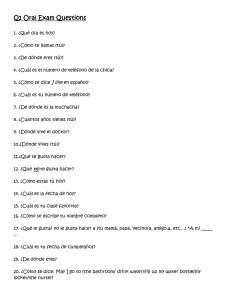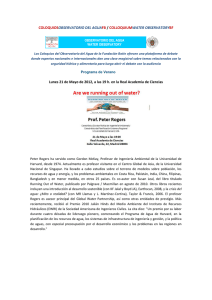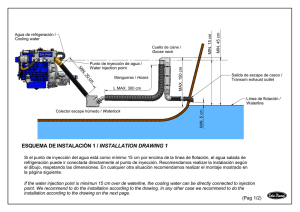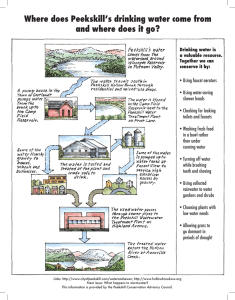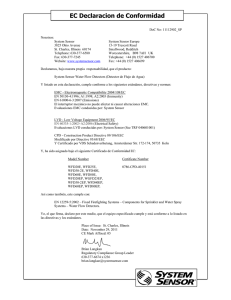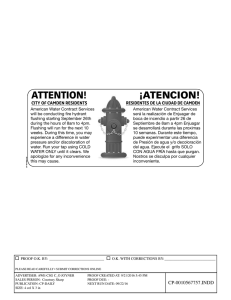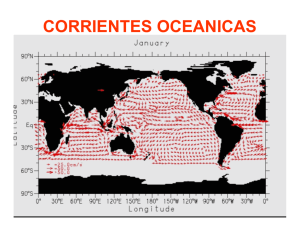definición y diseño básico de un sistema de servicios auxiliares
Anuncio
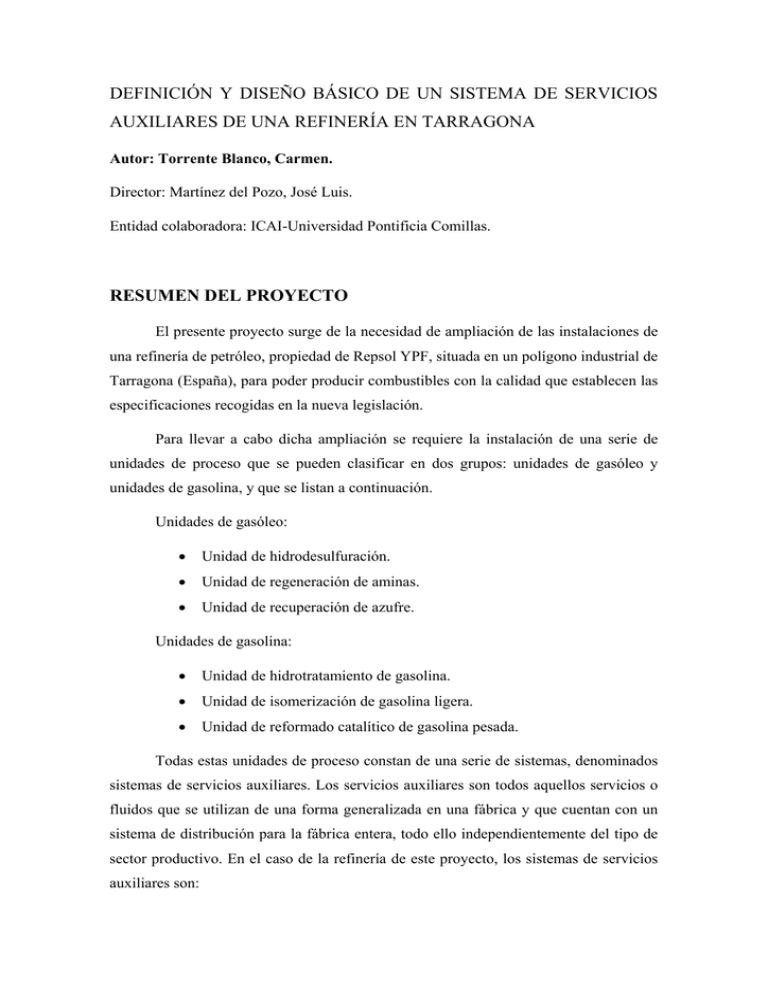
DEFINICIÓN Y DISEÑO BÁSICO DE UN SISTEMA DE SERVICIOS AUXILIARES DE UNA REFINERÍA EN TARRAGONA Autor: Torrente Blanco, Carmen. Director: Martínez del Pozo, José Luis. Entidad colaboradora: ICAI-Universidad Pontificia Comillas. RESUMEN DEL PROYECTO El presente proyecto surge de la necesidad de ampliación de las instalaciones de una refinería de petróleo, propiedad de Repsol YPF, situada en un polígono industrial de Tarragona (España), para poder producir combustibles con la calidad que establecen las especificaciones recogidas en la nueva legislación. Para llevar a cabo dicha ampliación se requiere la instalación de una serie de unidades de proceso que se pueden clasificar en dos grupos: unidades de gasóleo y unidades de gasolina, y que se listan a continuación. Unidades de gasóleo: Unidad de hidrodesulfuración. Unidad de regeneración de aminas. Unidad de recuperación de azufre. Unidades de gasolina: Unidad de hidrotratamiento de gasolina. Unidad de isomerización de gasolina ligera. Unidad de reformado catalítico de gasolina pesada. Todas estas unidades de proceso constan de una serie de sistemas, denominados sistemas de servicios auxiliares. Los servicios auxiliares son todos aquellos servicios o fluidos que se utilizan de una forma generalizada en una fábrica y que cuentan con un sistema de distribución para la fábrica entera, todo ello independientemente del tipo de sector productivo. En el caso de la refinería de este proyecto, los sistemas de servicios auxiliares son: Sistema de agua de refrigeración. Sistema de agua tratada. Sistema de vapor. Sistema de gas combustible. Sistema de aire de instrumentos. Sistema de nitrógeno. Sistema de electricidad. El primer objetivo de este proyecto es la descripción básica de los sistemas de servicios auxiliares anteriores, incluyendo sus consumos, temperaturas, presiones y caudales de operación, etc. Una vez realizada la descripción de los sistemas nombrados anteriormente, se hará un diseño básico del sistema de agua de refrigeración de la refinería. El sistema de agua de refrigeración tiene la función de enfriar el agua que recibe de cada una de las unidades de proceso. Estas unidades están procesando combustibles y requieren de un sistema auxiliar para refrigerar los equipos. Por tanto, el sistema de agua de refrigeración diseñado tendrá que ser capaz de satisfacer la demanda energética de estas unidades de proceso. Dicha demanda energética se muestra, a continuación, en la Tabla 1. Potencia a disipar [Mkcal/h] Hidrodesulfuración 1,66 Regeneración de aminas 0,18 Recuperación de azufre 2,1 Hidrotratamiento de gasolina 0,7 Isomerización de gasolina ligera 0,36 Reformado catalítico de gasolina pesada 0,75 Total 5,75 Tabla 1. Demanda energética de las unidades de proceso a refrigerar. Unidad Con el objetivo de satisfacer esta demanda energética se ha decidido instalar un sistema de refrigeración que utilice el agua como fluido intercambiador de calor. Será de circuito cerrado y con una torre de tipo evaporativo, tiro inducido y de flujo a contracorriente. El agua sale de las unidades de proceso a una temperatura de 38 ºC y el sistema de refrigeración debe disminuir su temperatura hasta 28 ºC para que, al regresar de nuevo a las unidades de proceso, el agua sea capaz de refrigerar sus equipos. Las condiciones climáticas de diseño para la torre de refrigeración se establecen para cubrir las necesidades energéticas en los meses de verano, por ser estos los más restrictivos. Estas condiciones climáticas son: la humedad relativa, de 68,75 % y la temperatura seca, de 26,5 ºC. En este proyecto se llevará a cabo un diseño básico de la torre de refrigeración y se calcularán los caudales de agua y de aire que interactúan en el interior de dicha torre. También se llevará a cabo el dimensionamiento de los ventiladores y las bombas de impulsión de agua de refrigeración que se van a utilizar, así como del sistema de distribución del agua. Por último, se llevará a cabo un presupuesto total de la instalación, que incluirá ingeniería, adquisición de equipos, transporte, implantación y montaje. Los principales resultados obtenidos tras el estudio y cálculo de aquellas magnitudes que son necesarias para cubrir la demanda energética de las unidades de proceso son los siguientes: Para la torre de refrigeración: El caudal volumétrico total de agua necesario para refrigerar las unidades de proceso es de 576 m3/h y el caudal másico de 160 kg/s. La relación entre los caudales de agua y aire (relación L/G) es de 1,3, siendo el caudal másico de aire de 443 kg/s. Para optimizar el proceso, la torre de refrigeración constará de dos celdas de capacidad 288 m3/h. Se utilizará el modelo de relleno SNCS 20 en cada una de las dos celdas. La altura del relleno en cada celda es de 1,5 m, repartidos en tres pisos. Se adquirirán 120 bloques de dicho relleno. Cada celda constará de un ventilador de 2764 mm, una presión de 230,54 Pa y una potencia consumida de 12 kW. Para el balance del agua: El número de ciclos de concentración necesario para disminuir el riesgo de corrosión e incrustaciones es de 4 ciclos. Al tratarse de un circuito cerrado, el caudal de agua debe ser constante, por lo que para compensar las pérdidas de caudal, es necesario aportar un caudal de reposición de 11,9 m3/h. Los caudales por pérdidas se deben a la evaporación, el arrastre y el proceso de purga, siendo dichos caudales: 8,86 m3/h, 0,0058 m3/h y 2,95 m3/h, respectivamente. Para el sistema de distribución del agua: Los diámetros de las tuberías han sido dimensionados en función del caudal de agua que circula por ellas y la velocidad de la misma, obteniéndose los siguientes diámetros normalizados que se muestran en la Tabla 2. Diámetro [pulgadas] Caudal [m3/h] Velocidades reales [m/s] Pérdida de carga real [kg/cm2/km] 12 576 2,18 0,15 1,5 12 2,9 1,6 12 599 2,28 0,09 12 599 2,28 0,16 Filtro 3 23 1,40 0,22 Purga 0,75 3 2,88 1,77 12 576 2,18 0,15 Líneas Agua refinería Agua reposición Aspiración de la bomba Impulsión de la bomba Retorno a la refinería Tabla 2. Características de las líneas. Para el presupuesto: El coste total de la instalación del sistema de agua de refrigeración, incluyendo la ingeniería, la adquisición de los materiales y equipos, el transporte, los consumos eléctricos durante la construcción, la instrumentación, el montaje, la mano de obra y su supervisión y la obra civil asciende a 1.834.826,42 €. ABSTRACT This project arises from the need of expansion of the facilities of an oil refinery, owned by Repsol YPF, located in an industrial area of Tarragona (Spain), in order to produce quality fuels that establish the specifications contained in the new legislation. To perform this enlargement requires the installation of a series of processing units, which can be classified in two groups: diesel units and gasoline units, and they are listed below. Diesel units: • Hydrodesulphurization unit. • Amine regeneration unit. • Sulfur recovery unit. Gasoline units: • Gasoline hydrotreatment unit. • Light gasoline isomerization unit. • Renovated unit catalytic heavy petrol. All these processing units consist of a series of systems, known as ancillary services systems. Auxiliary services are those services that are all or fluids that are used in a way in a factory and accounts with one distribution system for the entire factory, all this regardless of the type of productive sector. In the case of the refinery of this project, systems of ancillary services are: • Cooling water system. • System of treated water. • Steam system. • Fuel gas system. • Instrument air system. • Nitrogen system. • Electricity system. The first objective of this project is the basic description of systems ancillary services above, including their consumption, temperatures, pressures and flows of operation, etc. Once the description of the systems named above is done, a basic design of the refinery cooling water system will be made. The water cooling system has the function of cooling water, which receives from each of the process units. Those units being processed fuels and require a system auxiliary to cool the equipment. Therefore, designed cooling water system will have to be able to meet the energy demand for these units. The energy demand is shown below, in table 1. Power to dissipate [Mkcal/h] Hydrodesulphurization 1.66 Regeneration of amines 0.18 Sulfur recovery 2.1 Gasoline Hydrotreating 0.7 Isomerization of light gasoline 0.36 Catalytic reforming heavy fuel 0.75 Total 5.75 Table 1. Energy demand of the processing units to refrigerate. Units In order to meet this demand for energy has decided to install a cooling system that uses water as a heat exchanger fluid. It will be closed circuit and shot with a tower of evaporative type, induced-flow counter-current. Water comes out of the processing units at a temperature of 38 ° C and cooling system must decrease its temperature up to 28 ° C so, returning back to the processing units, water is able to cool their computers. The climatic conditions of design for cooling tower are set to meet the energy needs in the summer months, these being the most restrictive. These climatic conditions are: the 68,75%, relative humidity and dry temperature of 26.5 ° C. In this project, a basic design of cooling tower will take place and flows of water and air that interact in the interior of the Tower will be calculated. Also will carry out the dimensioning of the fans and drive of cooling water pumps that are to be used, as well as the water distribution system. Finally, will carry out a total budget for the facility, which will include engineering, acquisition of equipment, transportation, implementation and installation. The main results obtained from the study and calculation of those variables that are necessary to meet the energy demand of the processing units are as follows: For the cooling tower: • The total flow rate volume of water necessary to cool the processing units is 576 m3/h and the mass flow rate of 160 kg/s. • The relationship between the flow of water and air (l/g ratio) is 1.3, being the mass flow rate of air of 443 kg/s. • To optimize the process, cooling tower will consist of two-cell capacity 288 m3/h. • Filling SNCS 20 model is used in each of the two cells. The filling into each cell height is 1.5 m, spread over three floors. 120 the filler blocks will be acquired. • Each cell will consist of a fan of 2764 mm, a pressure of 230,54 Pa and a power of 12 kW consumed. Water balance: • The number of cycles of concentration required to reduce the risk of corrosion and scale is 4 cycles. • It is a closed circuit, the water flow must be constant, so to compensate for the losses of flow, it is necessary to provide a flow of replenishment of 11.9 m3/h. Flows for losses due to evaporation, the drag and the process of purging, being these flows: 8,86 m3/h and 0,0058 m3/h 2.95 m3/h, respectively. For the water distribution system: • The diameters of the pipes have been dimensioned according to the volume of water flowing through them and the same speed, resulting in the following standar diameters that are shown in table 2. Diameter [inch] Flow [m3/h] Actual speed [m/s] Loss of actual load [kg/cm2km] Water refinery 12 576 2.18 0.15 Water replenishment 1.5 12 2.9 1.6 Suction pump 12 599 2.28 0.09 Pump drive 12 599 2.28 0.16 Filter 3 23 1.40 0.22 Purge 0.75 3 2.88 1.77 12 576 2.18 0.15 Lines Return to the refinery Table 2. Lines features. Budget: • The total cost of the installation of the cooling water system, including engineering, procurement of materials and equipment, transport, electrical consumption during the construction, instrumentation, mounting, labor and supervision and the civil works, is € 1.834.826,42.
